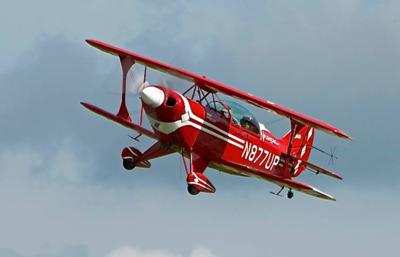Fri, Jul 10, 2015
Steven O’Berg Was On His Ninth Of 10 Planned Maneuvers
The NTSB has released its preliminary report from an accident at the Cameron Air Show at Cameron (MO) Memorial Airport (KEZZ) on June 27th. The accident fatally injured air show pilot Steven O'Berg.

According to the report, at about 1353 CDT, the Christen Industries Pitts S-2B, N877UP, being flown by O'Berg sustained substantial damage when it impacted terrain during the air show performance. The airplane was registered to and operated by the pilot under the provisions of the 14 Code of Federal Regulations as a Part 91 airshow flight. Day visual meteorological conditions prevailed for the airshow demonstration flight that departed from EZZ about 1330. No flight plan was filed.
The pilot's flight demonstration card used during the airshow indicated that the pilot planned to do 10 aerobatic maneuvers during the flight. For the ninth maneuver, it indicated that he planned to do a Lomcevak maneuver. An airshow pilot who was familiar with the accident pilot's airshow routine, reported that the accident pilot intended to do a 45-degree knife-edge climb, perform the Lomcevak maneuver, and then continue the knife-edge climb. Video recordings taken by persons on the ground showed the airplane flying through the planned routines. Between the eighth and ninth aerobatic maneuvers, the videos showed the airplane doing a course reversal, and then flying straight and level before entering into a knife-edge climb. During the knife-edge climb, the airplane appeared to enter the Lomcevak maneuver by doing a climbing snap-roll to the left. Then the nose of the airplane pitched down and the airplane tumbled two times to the left while descending. The airplane appeared to enter a left spin and
completed about two and a half revolutions before it impacted the terrain.

The airplane impacted the trees and terrain in a shallow nose down attitude with a high vertical descent rate. The engine compartment, fuselage, wings, and empennage remained intact and there was no post impact ground fire. The engine compartment exhibited upward crushing, and the leading edges of the wings did not exhibit aft crushing. Flight control continuity was confirmed from all flight control surfaces to their respective cockpit controls. The elevator trim continuity was confirmed from the elevator trim tabs to the elevator trim control.
The engine will be shipped to the manufacturer for an engine teardown examination. The videos and still photographs of the accident flight will be examined at the National Transportation Safety Board's (NTSB) Vehicle Recorder laboratory.
(O'Berg's Pitts pictured in file photos)
More News
The Industry Continues to be Rocked By Some Questionable Operations Recent investigations and a great deal of data has resulted in ANN’s SportPlane Resource Guide’s rep>[...]
Make Sure You NEVER Miss A New Story From Aero-News Network Do you ever feel like you never see posts from a certain person or page on Facebook or Instagram? Here’s how you c>[...]
Visual Approach Slope Indicator (VASI) An airport lighting facility providing vertical visual approach slope guidance to aircraft during approach to landing by radiating a directio>[...]
Airport Marking Aids Markings used on runway and taxiway surfaces to identify a specific runway, a runway threshold, a centerline, a hold line, etc. A runway should be marked in ac>[...]
Aero Linx: The Skyhawk Association The Skyhawk Association is a non-profit organization founded by former Skyhawk Pilots which is open to anyone with an affinity for the A-4 Skyhaw>[...]
 Unfortunate... ANN/SportPlane Resource Guide Adds To Cautionary Advisories
Unfortunate... ANN/SportPlane Resource Guide Adds To Cautionary Advisories ANN FAQ: Turn On Post Notifications
ANN FAQ: Turn On Post Notifications ANN's Daily Aero-Term (04.29.24): Visual Approach Slope Indicator (VASI)
ANN's Daily Aero-Term (04.29.24): Visual Approach Slope Indicator (VASI) ANN's Daily Aero-Term (04.28.24): Airport Marking Aids
ANN's Daily Aero-Term (04.28.24): Airport Marking Aids ANN's Daily Aero-Linx (04.28.24)
ANN's Daily Aero-Linx (04.28.24)




